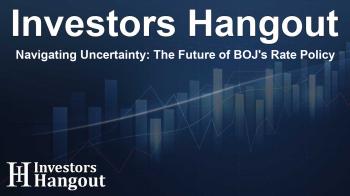Navigating Uncertainty: The Future of BOJ's Rate Policy

Understanding the BOJ's Shift in Communication
The Bank of Japan (BOJ) recently signaled a notable change in its approach to monetary policy, particularly regarding interest rates. After clearly indicating a rate hike, analysts suggest that the BOJ may return to a more vague communication style, allowing for greater flexibility in future policy decisions.
The Impact of Clear Guidance
Historically, the BOJ's communication has been pivotal in shaping market expectations. The central bank surprised many investors in a previous announcement by maintaining steady rates, but its recent clarity about the rate increase allowed markets to anticipate the decision confidently. Such transparency had previously been a hallmark of the U.S. Federal Reserve, providing a model for the BOJ but also establishing a high bar for future communications.
Concerns About Market Reaction
Despite successfully managing market reactions this time, BOJ officials remain cautious. With a fluctuating economy and uncertain global influences, there is a significant concern about the extent to which rate hikes may hinder economic growth. Bank Governor Kazuo Ueda has expressed hesitation about being overly responsive to market signals and conveyed a desire to maintain some unpredictability in policy announcements.
Pre-Announcement Practices
In a bid to prevent market shock, Ueda and his team employed a strategy of signaling upcoming decisions. By discussing the potential for future rate increases publicly, they essentially pre-announced the December hike. This cautious approach, albeit unusual for the BOJ, aimed to ensure a smoother transition toward higher interest rates without causing unnecessary market turbulence.
Understanding the 'Neutral Rate'
One of the central struggles for the BOJ is determining the 'neutral' interest rate—where the economy balances without overheating or stalling. Analysts suggest a range between 1% and 2.5%, but the BOJ's current policy rates remain significantly below this threshold. Without a clear understanding or consensus on this neutral rate, the BOJ faces challenges in deciding how swiftly to proceed with future rate hikes.
Potential Economic Implications
As the BOJ navigates these uncertainties, it appears increasingly reliant on domestic economic signals, including wage growth and consumer spending. Recent increases have been justified by anticipated sustained wage gains; however, the actual impact of rising costs of living on consumer behavior remains uncertain. Furthermore, external threats, such as potential tariffs from global leaders, could adversely affect Japan's economy, which is heavily reliant on exports.
Future Prospects for the BOJ
Looking ahead, the BOJ recognizes its delicate balancing act: managing inflationary pressures while ensuring economic stability. If it continues to provide specific forward guidance, it risks being perceived as inflexible or out of touch with real economic conditions. Conversely, a reversion to ambiguity could hamper market understanding and predictions of policy direction.
Growing Influences on Monetary Policy
The environment surrounding the BOJ's decision-making is undeniably complex. Woven into the fabric of domestic monetary policy are global influences and shifting market sentiments. As the central bank analyzes potential future rate hikes, it will need to consider public perception and broader economic trends while keeping an eye on external threats.
Frequently Asked Questions
What is the current stance of the BOJ on interest rates?
The BOJ recently raised interest rates but may revert to a more ambiguous communication style moving forward.
Why did the BOJ previously maintain steady rates?
Previous decisions were influenced by concerns over the global economic outlook and domestic economic conditions.
What is a 'neutral' interest rate?
The neutral interest rate is the level at which monetary policy neither stimulates nor restricts economic growth.
How do global factors impact the BOJ's decisions?
Global events, especially related to trade policies and geopolitical stability, can significantly influence the Japanese economy and the BOJ's policy decisions.
What challenges does the BOJ face in the current economic climate?
The BOJ must manage rising inflation pressures while ensuring that economic growth remains stable amidst external uncertainties.
About The Author
Contact Addison Perry privately here. Or send an email with ATTN: Addison Perry as the subject to contact@investorshangout.com.
About Investors Hangout
Investors Hangout is a leading online stock forum for financial discussion and learning, offering a wide range of free tools and resources. It draws in traders of all levels, who exchange market knowledge, investigate trading tactics, and keep an eye on industry developments in real time. Featuring financial articles, stock message boards, quotes, charts, company profiles, and live news updates. Through cooperative learning and a wealth of informational resources, it helps users from novices creating their first portfolios to experts honing their techniques. Join Investors Hangout today: https://investorshangout.com/
The content of this article is based on factual, publicly available information and does not represent legal, financial, or investment advice. Investors Hangout does not offer financial advice, and the author is not a licensed financial advisor. Consult a qualified advisor before making any financial or investment decisions based on this article. This article should not be considered advice to purchase, sell, or hold any securities or other investments. If any of the material provided here is inaccurate, please contact us for corrections.

